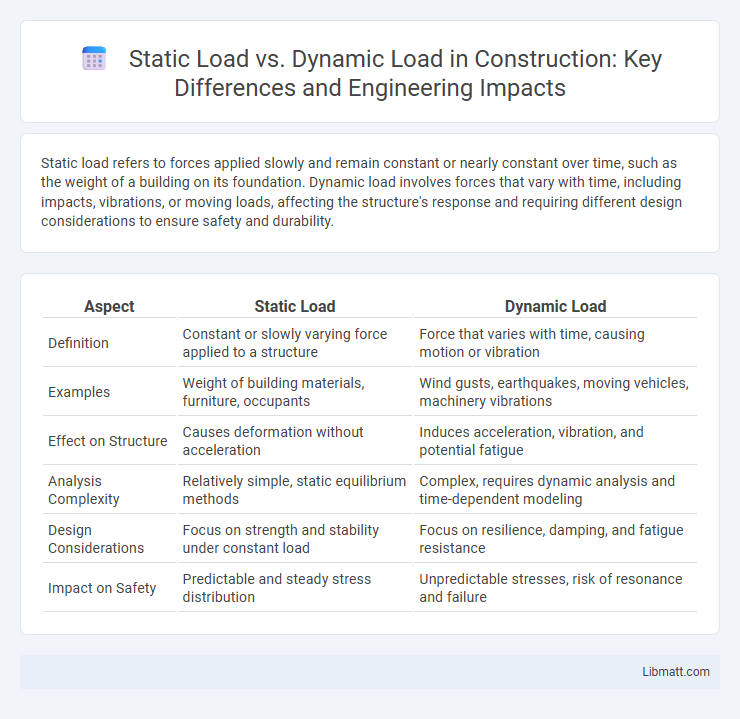Static load refers to forces applied slowly and remain constant or nearly constant over time, such as the weight of a building on its foundation. Dynamic load involves forces that vary with time, including impacts, vibrations, or moving loads, affecting the structure's response and requiring different design considerations to ensure safety and durability.
Table of Comparison
| Aspect | Static Load | Dynamic Load |
|---|---|---|
| Definition | Constant or slowly varying force applied to a structure | Force that varies with time, causing motion or vibration |
| Examples | Weight of building materials, furniture, occupants | Wind gusts, earthquakes, moving vehicles, machinery vibrations |
| Effect on Structure | Causes deformation without acceleration | Induces acceleration, vibration, and potential fatigue |
| Analysis Complexity | Relatively simple, static equilibrium methods | Complex, requires dynamic analysis and time-dependent modeling |
| Design Considerations | Focus on strength and stability under constant load | Focus on resilience, damping, and fatigue resistance |
| Impact on Safety | Predictable and steady stress distribution | Unpredictable stresses, risk of resonance and failure |
Introduction to Static Load and Dynamic Load
Static load refers to a stationary force applied steadily to a structure or material, causing deformation without movement, commonly analyzed in buildings and bridges for stability under constant weight. Dynamic load involves forces that vary with time, such as vibrations, impacts, or oscillations, requiring consideration of inertia and damping effects in design and engineering. Understanding the differences between static and dynamic loads is crucial for ensuring structural integrity under various real-world conditions.
Key Definitions: Static Load vs Dynamic Load
Static load refers to a constant force or weight applied to a structure that remains steady over time, such as the weight of a building or a parked vehicle. Dynamic load involves forces that vary with time, including impacts, vibrations, or moving loads like wind gusts, earthquakes, and traffic. Understanding the difference between static and dynamic loads is crucial for designing structural elements that can withstand both persistent and fluctuating stresses.
Fundamental Differences Between Static and Dynamic Load
Static load refers to a constant, unchanging force applied to a structure or object, while dynamic load involves varying forces that change over time due to motion or impact. The fundamental differences between static and dynamic load lie in their nature of application: static loads cause only stress and strain without motion, whereas dynamic loads induce additional effects such as vibration, fatigue, and inertia forces. Understanding these distinctions is crucial for designing structures that can safely withstand both steady forces and fluctuating impacts affecting Your project's integrity.
Real-World Examples of Static Loads
A static load refers to a constant or slowly varying force applied to a structure, such as the weight of a building, furniture, or stationary vehicles. Your infrastructure must support these loads without deformation, ensuring safety and stability under consistent pressure. Examples include the weight of a bridge deck, stored materials in a warehouse, and the permanent fixtures in a residential building.
Real-World Applications of Dynamic Loads
Dynamic loads play a critical role in engineering applications such as bridges, aircraft, and automotive suspensions where forces vary rapidly over time due to motion or impact. Structures like skyscrapers and offshore platforms must be designed to withstand seismic activity and wind gusts, which introduce dynamic loading conditions affecting stability and safety. Understanding these fluctuating forces enables precise modeling and material selection to optimize performance and durability in real-world conditions.
Impact on Structural Design and Safety
Static loads, such as dead weight and permanent fixtures, impose constant forces on structures, enabling engineers to design with predictable stress distributions and safety factors. Dynamic loads, including wind, earthquakes, and moving vehicles, introduce variable and time-dependent forces that require advanced analysis to ensure structural resilience and prevent failure under fluctuating conditions. Incorporating both load types into structural design is crucial for optimizing safety margins and ensuring long-term durability under diverse environmental and operational scenarios.
Methods of Calculating Static and Dynamic Loads
Static loads are calculated using methods such as the dead load analysis, where forces remain constant over time, often determined by summing the weights of structural components and fixed equipment. Dynamic load calculations involve more complex techniques like modal analysis and time-history analysis to account for varying forces caused by acceleration, impact, or vibration, often requiring computational tools to simulate real-world conditions. Your structural design's safety and reliability depend on accurately applying these calculation methods to assess both static and dynamic forces effectively.
Challenges in Managing Dynamic Loads
Managing dynamic loads presents challenges due to their constantly changing magnitude, direction, and point of application, which complicates accurate analysis and design. Unlike static loads that remain constant or change slowly, dynamic loads require sophisticated modeling techniques such as time-history analysis or finite element methods to predict structural responses effectively. Your engineering solutions must account for factors like vibration, impact, and fatigue to ensure safety and durability under varying operational conditions.
Importance in Engineering and Construction
Static load and dynamic load are critical concepts in engineering and construction, as they influence the design and safety of structures. Static load refers to constant or slowly varying forces, such as the weight of a building or furniture, while dynamic load involves forces that change rapidly, like wind, earthquakes, or moving vehicles. Understanding these load types ensures your structures can withstand both everyday pressures and sudden impacts, preventing structural failure and prolonging durability.
Conclusion: Choosing the Right Load Analysis
Selecting the appropriate load analysis depends on the application's operational conditions and safety requirements. Static load analysis suits structures subjected to constant or slow-changing forces, while dynamic load analysis is essential for systems experiencing variable, impact, or oscillatory forces. Accurate load assessment ensures structural integrity, optimal performance, and longevity by addressing the specific nature of the applied forces.
Static load vs dynamic load Infographic

 libmatt.com
libmatt.com